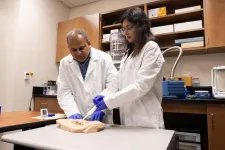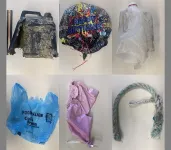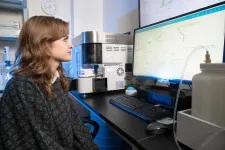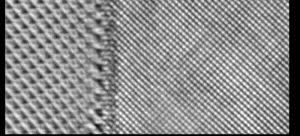(Press-News.org) Video available here.
Without proper medical invention, injuries sustained from traffic collisions, serious workplace accidents or weapons may result in fatal hemorrhaging.
University of Central Florida researchers aim to prevent such bleeding in potentially deadly situations with a new hemostatic spongelike bandage with antimicrobial efficacy that they recently developed and detailed in a newly published study in the journal Biomaterials Science.
“What happens in the field or during an accident is due to heavy bleeding, patients can die,” says Kausik Mukhopadhyay, assistant professor of materials science and engineering at UCF and study co-author. “These fatalities usually occur in the first 30 minutes to one hour. Our whole idea was to develop a very simple solution that could have the hemostatic efficacy within that time. If you can save the patient, then the doctors and the nurses can then save the patient.”
Chemistry and Mechanisms
The method Mukhopadhyay and his team developed is called SilFoam as it’s more of a foam than a traditional bandage wrap. SilFoam is a liquid gel comprised of siloxanes (silicon and oxygen) that is delivered via a special two-chamber syringe which rapidly expands into a spongy foam upon exposure to each other within the wound in under one minute. The sponge applies pressure to restrict the hemorrhage at the delivery site while also serving as an antibacterial agent because of the silver oxide in it.
For every five milliliters of gel injected, you can expect an expansion of about 35 milliliters, Mukhopadhyay says.
“Anytime you have a profuse bleeding or bleeding, you want to press on top and stop the bleeding,” he says. “So, what we did here is actually the same thing. Instead of putting the hand, we injected it, and it creates a voluminous expansion.”
Mukhopadhyay and his collaborators found that their sponge also resulted in a more gentle removal.
“The adhesive property of this bandage is optimized so that when you take it out from the system, the smaller vessels don’t get ruptured, but it has the right amount of addition that can adhere to the muscles, veins and the arteries so that the blood doesn’t leak,” he says.
The sponge’s porosity and adhesion properties help it expand and seal the wound, allowing the body’s natural clotting process to take over, Mukhopadhyay says.
“During the reaction, it generates a little bit amount of heat that helps the process very fast,” he says. “On top of that, oxygen gas as part of the reaction’s byproduct, tries to come out. So instead of making it a cross-linkable rubber, it’s a soft sponge with a lot of internal porosity.”
Experimentation and Methods
Researching ways to address wounds requires special care and consideration to ensure no harm comes to test subjects, however, the researchers were able to bypass this by using a functional anatomic model to test their methods.
They used specially crafted mannequins designed with realistic blood vessels and wounds developed by a local company called SIMETRI to test their foam on in hopes the preliminary results were promising enough to proceed with further testing.
“One of the most important parts of this was that we used non-invasive models,” Mukhopadhyay says. “At this phase, we can get approvals and move forward to study the in vivo models. At this stage, there are no psychological effects on vets or surgeons either.”
The experimentation showed promise, especially when the researchers compared SilFoam to five other existing treatment methods.
They found that SilFoam had many advantages such as significantly less leakage, room-temperature storage versus requiring cold temperatures, ultimately lower cost of materials, little to no training requirements to use the syringe.
Pritha Sarkar, a graduate student in the materials science department at UCF, assisted with the experimentation.
“We had to check the reactivity of the two parts, because we wanted enough oxygen gas that can expand the sponge, but at the same time, we didn’t want the material to get too hot, because the reaction itself generates heat,” she says.
Sarkar texted the toxicity and strength of the materials as well to ensure it was safe for human bodies and durable yet not too rigid.
She also worked to make sure the composition of the SilFoam doesn’t harm the patient upon removal.
“If you have something that’s very sticky, like a bandage that you can slap onto your wound, that that will prevent blood from coming out, but if you want to remove that bandage, it can cause tissue damage or pain,” Sarkar says. “Our polymer system doesn’t stick to your skin, so it’s very easy to remove. We have a dressing that can expand onto your wound and seal it shut, but at the same time, once it’s done its job, you can remove it very easily.”
Reducing Infections and Next Steps
The antibacterial component of the research was through Melanie Coathup, a UCF College of Medicine professor and director of the Biionix Cluster at UCF.
She works alongside material scientists and mechanical engineers with the goal of creating new medical technologies and therapies.
“My post-doc Dr. Abi Sindu Pugazhendhi and I worked alongside Dr. Mukhopadhyay and team to investigate the potency of his material and how well it stopped bacterial growth,” Coathup says. “We assessed bacteria that would typically infect a traumatic injury to the torso, and our results showed that the material was highly effective and so utilizing this material within the bandage system developed by Dr. Mukhopadhyay and confirming its efficacy as a novel hemostatic and antibacterial strategy is a great and important find.”
She says the opportunity to save lives as part of this research was extremely rewarding.
“The research is significant, because at the moment, there are no effective treatments available to treat people with these conditions, and new strategies are really needed,” Coathup says. “This means that teaming up with Dr. Mukhopadhyay to investigate a novel antibacterial sponge that could in the future provide life-saving treatment following major traumatic injury, was an absolute pleasure and right up my street.”
Mukhopadhyay also recently received a GAP award to assist in licensing SilFoam and deploying it. He says the next step is to collaborate with the University of Nebraska Medical Center and perform in vivo studies at their facilities.
Those interested in licensing this technology may learn more here.
Researcher’s Credentials
Mukhopadhyay is an assistant professor of materials science and engineering at UCF, and he directs the Hybrid Materials and Surfaces Laboratory. He received his doctoral degree in chemistry in 2004 from the National Chemical Laboratory in Pune, India. Mukhopadhyay joined UCF in Fall 2017 as a senior lecturer and researcher.
Coathup joined UCF in 2017 and is a professor of medicine and director of Director of the Biionix (Bionic Implants, Materials and Interfaces) Cluster. Prior to UCF, she was an associate professor at University College London where she also earned her doctoral degree in orthopedic implant fixation.
END
Life-saving spongelike “bandage” developed by UCF researchers rapidly stops hemorrhaging and mitigates risk of infection
A UCF team of researchers worked together to create a liquid gel that quickly transforms into a spongelike antimicrobial foam to stymie severe bleeding and ultimately preserve lives.
2024-10-16
ELSE PRESS RELEASES FROM THIS DATE:
Model reveals why debunking election misinformation often doesn’t work
2024-10-16
When an election result is disputed, people who are skeptical about the outcome may be swayed by figures of authority who come down on one side or the other. Those figures can be independent monitors, political figures, or news organizations. However, these “debunking” efforts don’t always have the desired effect, and in some cases, they can lead people to cling more tightly to their original position.
Neuroscientists and political scientists at MIT and the University of California at Berkeley have now ...
Project to integrate human and machine intelligence to address information integrity
2024-10-16
Identifying whether online information is faulty or ungrounded is important to ensure information integrity and a well-informed public. This was especially challenging during the COVID-19 pandemic when misinformation spread like wildfire across the Internet. A new project led by Dong Wang, associate professor in the School of Information Sciences at the University of Illinois Urbana-Champaign, will integrate diverse human and machine intelligence to examine multimodal data (e.g., text and image) that was produced during the pandemic. ...
Plastic pollution sounds just like food to deep-diving whales
2024-10-16
BEAUFORT, N.C. -- To whales that hunt with soundwaves in the lightless depths of the ocean, a torn plastic party balloon and a delicious squid seem to be remarkably similar, according to a new study that put some plastic beach trash through underwater acoustic testing.
"These acoustic signatures are similar, and this might be a reason that these animals are driven to consume plastic instead of, or in addition to, their prey," said Duke University graduate student Greg Merrill, who led the research.
"One hundred percent of plastic marine debris ...
Innovating in the corners where atoms meet
2024-10-16
How can we engineer materials that are stronger and lighter? What about new materials for extreme conditions such as in jet engines and spacecrafts?
The answer, says Fadi Abdeljawad, an associate professor of materials science and engineering in Lehigh University's P.C. Rossin College of Engineering and Applied Science, might be hidden in the infinitesimally tiny regions, or boundaries, where atoms in crystals come together.
Along with his collaborators at the U.S. Department of Energy's Center for Integrated Nanotechnologies (CINT), Abdeljawad is uncovering how those ...
Study offers better insights into quality of life for adults with congenital heart disease
2024-10-16
Washington, D.C. (October 16, 2024) – For the first time, adults living with congenital heart disease (CHD) now have valuable insights into their long-term quality of life through data from the Congenital Heart Initiative (CHI). CHI is the nation’s first and largest patient-focused registry for adults with CHD and released its first study involving over 4,500 participants from all 50 states.
This research, published today in JAMA Network Open, marks a significant step forward in making better information available for the ...
Researchers offer alternative to hydroxyurea in study of DNA replication process
2024-10-16
Researchers at Colorado State University have identified an alternate method to study changes during the DNA replication process in lab settings using genetically modified yeast. The new approach offers a clearer window than current drug methods used to understand cell cycle arrest – a fundamental mechanism that is key to treating cancers and genetic issues.
The findings were published in the Proceedings of the National Academy of Sciences and were led at CSU by Assistant Professor Grant Schauer in the Department of Biochemistry and Molecular Biology. The work focuses on hydroxyurea, a chemotherapy drug used ...
New diamond bonding technique a breakthrough for quantum devices
2024-10-16
Synthetic diamond is durable, inert, rigid, thermally conductive and chemically well-behaved—an elite material for both quantum and conventional electronics. But there’s one problem. Diamond only likes diamond.
It’s homoepitaxial, meaning it only grows on other diamonds, and integrating diamond into quantum or conventional computers, quantum sensors, cellphones, or other devices would mean sacrificing the diamond’s full potential or using large, expensive chunks of the precious material.
“Diamond stands alone in terms of its material properties, both for electronics—with its wide band gap, ...
Clean air and climate policies provide health benefits in New York City
2024-10-16
A new study analyzes the links between the enactment of major air pollution and climate policies in New York City and significant improvement in air quality during the period 1998-2021. It finds a cumulative beneficial effect of these policies both city-wide and among residents residing in communities that have been disproportionately affected by air pollution.
The study by environmental health scientists at Columbia University Mailman School of Public Health is published in the peer-reviewed journal Frontiers in Public Health.
“Because of the known significant associations between the pollutants studied and multiple adverse health effects, there are important implications for health ...
Folic acid may mitigate link between lead exposure during pregnancy and autistic behaviours in children
2024-10-16
New research gives another reason to take folic acid supplements while pregnant.
A new study by Simon Fraser University researchers has found that folate may weaken the link between blood-lead levels in pregnant women and autistic-like behaviours in their children.
Researchers from SFU’s Faculty of Health Sciences, led by PhD candidate Joshua Alampi, published the study in the journal Environmental Health Perspectives.
“Folic acid supplementation during pregnancy has numerous benefits to child health, especially brain development,” ...
MD Anderson Research Highlights for October 16, 2024
2024-10-16
HOUSTON ― The University of Texas MD Anderson Cancer Center’s Research Highlights showcases the latest breakthroughs in cancer care, research and prevention. These advances are made possible through seamless collaboration between MD Anderson’s world-leading clinicians and scientists, bringing discoveries from the lab to the clinic and back.
Novel therapeutic target overcomes treatment resistance in triple-negative breast cancer
Many patients with triple-negative breast cancer (TNBC) do not respond to combination ...
LAST 30 PRESS RELEASES:
Common brain parasite can infect your immune cells. Here's why that's probably OK
International experts connect infections and aging through cellular senescence
An AI–DFT integrated framework accelerates materials discovery and design
Twist to reshape, shift to transform: Bilayer structure enables multifunctional imaging
CUNY Graduate Center and its academic partners awarded more than $1M by Google.org to advance statewide AI education through the Empire AI consortium
Mount Sinai Health system receives $8.5 million NIH grant renewal to advance research on long-term outcomes in children with congenital heart disease
Researchers develop treatment for advanced prostate cancer that could eliminate severe side effects
Keck Medicine of USC names Christian Pass chief financial officer
Inflatable fabric robotic arm picks apples
MD Anderson and SOPHiA GENETICS announce strategic collaboration to accelerate AI-driven precision oncology
Oil residues can travel over 5,000 miles on ocean debris, study finds
Korea University researchers discover that cholesterol-lowering drug can overcome chemotherapy resistance in triple-negative breast cancer
Ushikuvirus: A newly discovered giant virus may offer clues to the origin of life
Boosting the cell’s own cleanup
Movement matters: Light activity led to better survival in diabetes, heart, kidney disease
Method developed to identify best treatment combinations for glioblastoma based on unique cellular targets
Self-guided behavioral app helps children with epilepsy sleep earlier
Higher consumption of food preservatives is associated with an increased risk of type 2 diabetes
NTU Singapore-led team captures first-ever ‘twitch’ of the eye’s night-vision cells as they detect light, paving the way for earlier detection of blindness-causing diseases
Global aviation emissions could be halved through maximising efficiency gains, new study shows
Fewer layovers, better-connected airports, more firm growth
Exposure to natural light improves metabolic health
As we age, immune cells protect the spinal cord
New expert guidance urges caution before surgery for patients with treatment-resistant constipation
Solar hydrogen can now be produced efficiently without the scarce metal platinum
Sleeping in on weekends may help boost teens’ mental health
Study: Teens use cellphones for an hour a day at school
After more than two years of war, Palestinian children are hungry, denied education and “like the living dead”
The untold story of life with Prader-Willi syndrome - according to the siblings who live it
How the parasite that ‘gave up sex’ found more hosts – and why its victory won’t last
[Press-News.org] Life-saving spongelike “bandage” developed by UCF researchers rapidly stops hemorrhaging and mitigates risk of infectionA UCF team of researchers worked together to create a liquid gel that quickly transforms into a spongelike antimicrobial foam to stymie severe bleeding and ultimately preserve lives.





